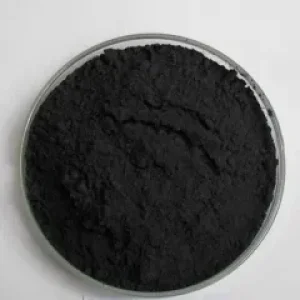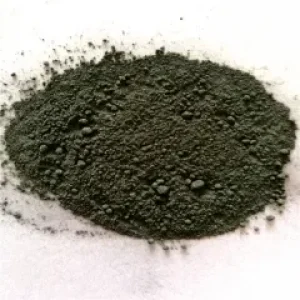Overview of Silicon Carbide SiC Powder
SiC Silicon carbide is a lightweight ceramic material with high-strength properties comparable to diamond. Silicon carbide is an excellent ceramic material for applications requiring good erosion, high temperature, and abrasive resistance.
Silicon carbide is also called emery, a type of semiconductor, namely silicon carbide semiconductor. Silicon carbide is a very hard synthetic crystal of silicon and carbon. The silicon carbide chemical formula is SiC. Since the end of the 19th century, silicon carbide has been an important material for sandpaper, grinding wheels, and cutting tools.
The microscopic shape of silicon carbide powder is hexagonal crystals, the Mohs hardness of silicon carbide is 9.2, the Vickers microhardness is 3000-3300 kg/mm2, the Knoop hardness is 2670-2815 kg/mm, and the microhardness is 3300 mm per cubic millimeter. It is higher than corundum in abrasives and second only to diamond, cubic boron nitride, and boron carbide. The density is generally considered 3.20 g/cm3, the natural bulk density of the silicon carbide abrasive is between 1.2-1.6 g/mm3, and the specific gravity is 3.20~3.25. Green silicon carbide uses petroleum coke and high-quality silica as its main raw materials, and salt is added as an additive. Its hardness is between corundum and diamond at high temperature through a resistance furnace, and its mechanical strength is higher than that of corundum.
Silicon carbide ceramic is a non-oxide ceramic used in many products that must function in thermal (high thermal and thermal shock) and mechanically demanding applications. On the contrary, single-crystal SiC has the best performance, but the manufacturing cost is high.
Silicon carbide comprises a tetrahedron of carbon and silicon atoms and has strong bonds in the crystal lattice. This produces a very hard material. Silicon carbide is not corroded by any acid, alkali, or molten salt up to 800°C.
Production Method of Silicon Carbide SiC Powder
The easiest way to make silicon carbide is to mix silica sand and carbon in an Acheson graphite resistance furnace at high temperatures between 1600°C (2,910°F) and 2,500°C (4,530°F).
Commercially, silicon carbide is produced by reacting a mixture of sand (silica) and coke (carbon) in a resistance furnace.
The self-conducting mixture is heated by direct current to temperatures up to 2700°C. A few days later, a product of iridescent black or green crystal aggregates was obtained, then crushed and graded. Crude grade (>10μm) silicon carbide powder cannot be sintered to a high density. For refractory applications, for example, use silicon nitride or silicon oxynitride, aluminosilicate glass, or a binder phase of self-bonding carbon and silicon to bond compacted coarse silicon carbide sand of the desired shape. When the degree of direct bonding can be obtained for electric heating element materials, the high-purity gradient silicon carbide sand is sintered at a temperature of about 2400°C. The production of high-density (low porosity) materials requires special conditions.
By decomposing the gaseous or volatile compounds of silicon and carbon in an inert atmosphere, silicon carbide can also be produced on a small scale so that the reaction product deposits the carbide on a suitable thermal substrate.
Finally, since carbon has significant solubility in liquid silicon, it can be obtained by crystallization from carbon-rich molten silicon that is supersaturated concerning SiC at high temperatures (~1650°C).
The final reaction formed the basis of mature self-bonding or reaction bonding technology combined with fine-grained silicon carbide powder.
Technical Parameter of Silicon Carbide Nanoparticles Nano SiC Powder
|
Product Name |
MF | Purity | Particle Size | Crystal Form | SSA | Color |
|
Silicon Carbide Nanoparticles |
SiC | 99% | 60nm, 500nm,300nm,1-3um | Cubic/ α/ β | 29m2/g | Gray green |
|
Particle size |
SiC (%) | Crystalline phase | Fe2O3(%) | F.C (%) | F.Si (%) | T.O |
|
60nm |
≥97.0 | β | ≤0.13 | ≤0.8 | ≤0.69 |
<1.4 |
| 300nm | ≥99.0 | β | ≤0.03 | ≤0.2 | ≤0.15 |
<0.8 |
| 500nm | ≥99.0 | α、β | ≤0.03 | ≤0.2 | ≤0.15 |
<0.8 |
| 1-3μm | ≥99.0 | α | ≤0.03 | ≤0.2 | ≤0.15 |
<0.8 |
| 325mesh | ≥99.0 | α | ≤0.03 | ≤0.2 | ≤0.15 |
<0.8 |
| Whisker | ≥99.0 | – | ≤0.03 | ≤0.2 | ≤0.15 |
<0.8 |
| other β SiC and α SiC for micro size (0-100um) are available | ||||||
Applications of Silicon Carbide SiC Powder
As a functional material in various optical and semiconductor devices, silicon carbide has attracted great interest from people. Due to its high stiffness, high conductivity, and low coefficient of thermal expansion, it is considered an ideal material for large optical mirror applications and radiation detectors. In addition, it is also used as a barrier material for high-temperature electronic equipment and parts that are highly susceptible to mechanical wear (such as bearing parts and seals). In addition, silicon carbide (SiC) is used in the fusion reactor’s first wall and cover assembly. Use candidate materials to coat nuclear fuel particles for high-temperature gas-cooled reactors. In addition, silicon carbide has many other uses.
Grinding and cutting tools SiC cutting disc
Due to silicon carbide material’s durability and low cost, it is a popular abrasive in modern gems. In manufacturing, it is used due to its hardness during grinding, honing, water jet cutting, and sandblasting.
Structural materials
Silicon carbide is used as a support and shelf material in high-temperature furnaces, for example, for firing ceramics, glass fusion, or glass casting. SiC kiln racks are much lighter and more durable than traditional alumina racks.
Car parts
Carbon ceramic (silicon carbide) disc brakes of the Porsche Carrera GT.
Siliconized carbon-carbon composites can be used for high-performance “ceramic” brake discs because they can withstand extreme temperatures. These brake discs are used in some road sports cars, super sports cars, and other high-performance cars, including the Porsche Carrera GT, Bugatti Veyron, Chevrolet Corvette ZR1, McLaren P1, Bentley, Ferrari, Lamborghini, and some specific high-performance Audi cars. Silicon carbide is also used in diesel particulate filters in sintered form. It is also an oil additive to reduce friction, emissions, and harmonics.
Casting silicon carbide crucible
In small and large casting applications, SiC is used in crucibles to hold the molten metal.
Electronic circuit components
Silicon carbide is the first commercially important semiconductor material. Henry Harrison (Henry Harrison Chase Dunwoody) applied for a patent for a crystal radio “silicon carbide” (synthetic silicon carbide) detector diode in 1906. This technology has been widely used in shipboard receivers.
Astronomy
The low coefficient of thermal expansion, high hardness, rigidity, and thermal conductivity make silicon carbide an ideal mirror material for astronomical telescopes.
Filament pyrometer
Test flame and glowing SiC fiber. The flame is about 7 cm (2.8 inches) high. Silicon carbide fibers, the filament high-temperature method, are used in optical technology to measure gas temperature.
Graphene production
Silicon carbide can produce graphene because its chemical properties can promote the epitaxial production of graphene on the surface of SiC nanostructures.
Steel production
Silicon carbide wafers for steelmaking. Silicon carbide is dissolved in an alkaline oxygen furnace used for steelmaking and used as fuel. The extra energy released allows the furnace to treat more waste with the same amount of molten iron. It can also increase the tapping temperature and adjust the carbon and silicon content.
Jewelry
As a gemstone used in jewelry, silicon carbide is called “Synthetic Moissanite” or simply “Moissanite” after the mineral name.
Fishing rod guide
Silicon carbide makes fishing tackle because of its durability and wear resistance. The silicon carbide ring is installed in a guide frame, usually stainless steel or titanium, to prevent the pipeline from contacting the bar stock. The lifting ring provides a low-friction surface, which can improve the casting distance while providing sufficient hardness to prevent the braided fishing line from causing wear.
Company Profile
My Carbides is a trusted global chemical material supplier & manufacturer with over 12-year-experience in providing super high-quality carbides and relatives products.
The company has a professional technical department and Quality Supervision Department, a well-equipped laboratory, and equipped with advanced testing equipment and after-sales customer service center.
If you are looking for high-quality Carbides, please feel free to contact us or click on the needed products to send an inquiry.
Payment Methods of Silicon Carbide SiC Powder
L/C, T/T, Western Union, Paypal, Credit Card etc.
Shipment of Silicon Carbide SiC Powder
It could be shipped by sea, by air, or by reveal ASAP as soon as repayment receipt.
Package of Silicon Carbide SiC Powder
Vacuum packing, 100g, 500g or 1kg/bag, 25kg/barrel, or as your request.
FAQ
How hard is silicon carbide?
Answer: Silicon carbide is extremely hard, second only to diamond, making it an ideal material for manufacturing high-performance cutting tools and wear-resistant parts.
How thermally stable is silicon carbide?
Answer: Silicon carbide has excellent thermal stability, can maintain stable performance in high temperature environments, and is not easily deformed or melted.
What effect does the diameter of silicon carbide particles have on its properties?
Answer: The diameter of silicon carbide particles has a significant impact on its processing performance and service life. Generally speaking, when the particle diameter is larger, the processing efficiency increases but the processing accuracy decreases; when the particle diameter is smaller, the processing accuracy increases but the processing efficiency decreases.
What are the applications of silicon carbide in power electronic devices?
Answer: Silicon carbide can be used as a material with high thermal conductivity and high hardness in power electronic devices to improve the efficiency and reliability of the device.
What role does silicon carbide play in ceramic products?
Answer: Due to its excellent high temperature resistance and corrosion resistance, silicon carbide can be used as an important raw material in ceramic products and used to manufacture high-temperature stoves, corrosion-resistant pipes, etc.
How resistant is silicon carbide to oxidation?
Answer: The surface of silicon carbide easily reacts with oxygen and is easily oxidized at high temperatures, so its oxidation resistance is a matter of concern. Usually, its antioxidant properties can be improved through methods such as surface coating treatment.





